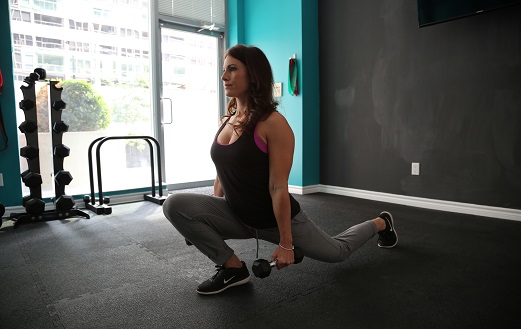TOP 3 REASONS TO EXERCISE WHILE
WORKING FROM HOME
by Christian Joseph S. Baluyot, RND
At the continuous peak of the pandemic, alternative working arrangements for professionals and skilled workers alike has been applied to comply to the safety guidelines against COVID-19 while still efficiently performing and meeting the demands of their respective jobs. The onset of the new normal posed a few risks in terms of the overall health and nutritional status of the working Filipinos in general. Aside from the access and actual intake of food, exercise has been different from the pre-pandemic period to what we are having now. From the open spaces in the parks and urban roads for walking and jogging, we are enclosed in the four walls of our homes while having hours of our days sitting in front of our “home office” and going through the day without even stretching or sweating a bit.
Some people may have the luxury of time to exercise a little but more often than not, they end up sitting for more hours for their work or leisure. This is exemplifying what we call “an exercising couch potato”. The dangers of the sedentary lifestyle have been longstanding and unaddressed by primary healthcare providers. In Functional Medicine, this sedentary lifestyle is viewed not only as a lifestyle problem but also a contributing factor in the risk of developing chronic diseases mainly focused on heart complications and metabolic disorders like Type 2 Diabetes Mellitus. To dive deep into the rewarding benefits of exercise, here are the TOP 3 REASONS WHY YOU SHOULD EXERCISE EVEN IF YOU ARE WORKING FROM HOME.
Exercise reduces risks of Cardiovascular Diseases. According to Front Cardiovasc Medicine in 2018, physical inactivity accounted for more heart-related illnesses (37%) than from smoking (19%). According to the American Heart Association, increasing daily movement, decreasing sedentary behavior, and aerobic, strength, and intensity physical activity are among the recommendation in order to prevent cardio-respiratory illnesses. These records alone can stand firm in the goal of reducing heart-related illness risks while promoting cardiometabolic health. Coupled with proper food, physical activity may help in maintaining a healthy heart.

Exercise prevents Aging and Neurodegeneration. Delaying brain aging, slowing neurodegeneration, improved cognitive processes, and promotion of self-being are a few of the reaping benefits of physical activity to brain health. Low to moderate exercises, short-interval intensity training, aerobic exercises, and mind-body meditation exercises are all proven ways on how to further take care of your brain. Research has suggested that exercise improves neuroplasticity by altering synaptic structure and function in various brain regions. Having a simple yet regular and consistent physical activity may positively affect the condition and state of the brain and support its wide array of functions in health and nutrition. When properly paired with mitochondrial or cellular energy foods, physical activity may promote life longevity with vitality among people who will commit to move and groove amidst the restricting conditions of the pandemic.

Exercise helps in boosting Immune System. In this time of the infectious COVID-19, maintaining your first line of defense – immune system – is beneficial in preventing risks of the virus. Evidence suggests that exercise has a profound effect on the functioning of the immune system. It is generally accepted that prolonged periods of intensive exercise training can depress immunity, while regular, moderate-intensity exercise is beneficial. Knowing your proper exercise prescription if beneficial in successfully implementing an exercise regimen. With proper food intake focusing on immune boosting nutrients - such as curcumin, quercetin, and resveratrol – and implementing a moderate-intensity exercise greatly increase your body’s defenses against the virus.
Aside from the reaping benefits of exercise, maintaining a good support system to help us in handling the anxiety, panics, and stress may positively affect how we deal with the pros and cons of working from home. More than the usual weight loss targets of those engaged in physical activity, there is a good set of beneficial effects that a simple, regular, and consistent exercise may bring as we battle COVID-19.
Keep posted on Go2Health’s Facebook https://web.facebook.com/go2health.ph and Instagram (Go2Health! (@go2health.ph) • Instagram photos and videos) accounts for access to various desk mobility exercises and knowing your exercise prescription.
Learn more about our Functional Weight Loss Program (https://go2health.ph/HealthPrograms.html) and COVID-19 Home Intervention Program (https://go2health.ph/Covid-19.html)
References :
Di Liegro CM, Schiera G, Proia P, Di Liegro I. Physical activity and brain health. Genes (Basel). 2019;10(9):720. doi:10.3390/genes10090720;
Bouaziz W, Schmitt E, Vogel T, et al. Effects of a short-term Interval Aerobic Training Programme with active Recovery bouts (IATP-R) on cognitive and mental health, functional performance and quality of life: a randomised controlled trial in sedentary seniors. Int J Clin Pract. 2019;73(1):e13219. doi:10.1111/ijcp.13219;
Hsu CL, Best JR, Davis JC, et al. Aerobic exercise promotes executive functions and impacts functional neural activity among older adults with vascular cognitive impairment. Br J Sports Med. 2018;52(3):184-191. doi:10.1136/bjsports-2016-096846;
Vaccaro MG, Izzo G, Ilacqua A, et al. Characterization of the effects of a six-month dancing as approach for successful aging. Int J Endocrinol. 2019;2019:2048391. doi:10.1155/2019/2048391;
de Oliveira Silva F, Ferreira JV, Plácido J, et al. Three months of multimodal training contributes to mobility and executive function in elderly individuals with mild cognitive impairment, but not in those with Alzheimer’s disease: a randomized controlled trial. Maturitas. 2019;126:28-33. doi:10.1016/j.maturitas.2019.04.217;
Zou L, Loprinzi PD, Yeung AS, Zeng N, Huang T. The beneficial effects of mind-body exercises for people with mild cognitive impairment: a systematic review with meta-analysis. Arch Phys Med Rehabil. 2019;100(8):1556-1573. doi:10.1016/j.apmr.2019.03.009;
Young DR, Hivert MF, Alhassan S, et al. Sedentary behavior and cardiovascular morbidity and mortality: a science advisory from the American Heart Association. Circulation. 2016;134(13):e262-79. doi:10.1161/CIR.0000000000000440;
Schmid D, Ricci C, Leitzmann MF. Associations of objectively assessed physical activity and sedentary time with all-cause mortality in US adults: the NHANES study. PLoS One. 2015;10(3):e0119591. doi:10.1371/journal.pone.0119591;
van der Velde JHPM, Schaper NC, Stehouwer CDA, et al. Which is more important for cardiometabolic health: sedentary time, higher intensity physical activity or cardiorespiratory fitness? The Maastricht Study. Diabetologia. 2018;61(12):2561-2569. doi:10.1007/s00125-018-4719-7;
American Heart Association recommendations for physical activity in adults and kids. American Heart Association. Reviewed April 18, 2018. Accessed January 5, 2021. https://www.heart.org/en/healthy-living/fitness/fitness-basics/aha-recs-for-physical-activity-in-adults;
Simpson RJ, Kunz H, Agha N, Graff R. Exercise and the regulation of immune functions. Prog Mol Biol Transl Sci. 2015;135:355-380. doi:10.1016/bs.pmbts.2015.08.001;
The End
